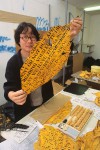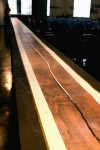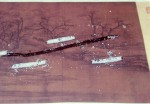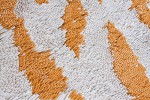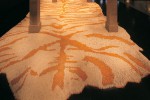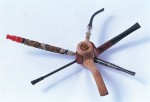Xu Bing: Tobacco Project explores the production and culture of tobacco as seen through the eyes of one of China’s most innovative contemporary artists. The exhibition combines important pieces from the artist’s earlier projects at Duke University in North Carolina and the Shanghai Gallery of Art in China with new work inspired by visits to tobacco farms, warehouses, and cigarette factories in Virginia. Altogether the exhibition spans a dozen years of Xu Bing’s work and surveys one of his most ambitious undertakings.
Background on the Artist
Xu Bing is considered one of the most important Chinese artists of his generation. Born in 1955, he lived through a tumultuous period in China’s history. After being sent to the countryside as a teen during the Cultural Revolution, he returned to Beijing to study and then teach printmaking at the Central Academy of Fine Arts during successive waves of tightening and loosening government control over the arts. A central and controversial figure in the Chinese New Wave movement, he moved to the United States in 1990 shortly after the Tiananmen uprising.
In 1999 Xu Bing was awarded a MacArthur Fellowship in recognition of his contributions, particularly in printmaking and calligraphy. A number of awards followed, including the Fukuoka Asian Culture Prize in 2003, the Wales International Visual Art Prize “Artes Mundi” in 2004, and the Southern Graphics Council Lifetime Achievement Award in 2006. Xu Bing was appointed vice president of the Central Academy of Fine Arts, one of the most important positions in the Chinese art system, in 2008.
A prolific and versatile artist, Xu Bing has created a range of works that explore traditional and experimental bookmaking and printmaking (best exemplified by his iconic installation Book from the Sky) and language (including his invention of Square Word Calligraphy and the ongoing Book from the Ground), as well as animals and nature.
Xu Bing has had solo exhibitions at the Arthur M. Sackler Gallery, Washington, D.C.; the New Museum of Contemporary Art, New York; the Joan Miro Foundation, Barcelona; and the National Gallery of Prague. He has also shown his work at many major international group exhibitions including the 45th and 51st Venice Biennales, the Biennale of Sydney, and the Johannesburg Biennale. Over the years, his work has appeared in high-school and college textbooks around the world including Abrams’ Art Past–Art Present, Gardner’s Art through the Ages, and Greg Clunas’s Chinese Art, which is part of the Oxford History of Art series.
VMFA Exhibition
Xu Bing uses tobacco—as a material and a subject—to explore a wide range of issues, from global trade and exploitation to the ironies of advertising a potentially harmful substance. As a print- and bookmaker, he is especially fascinated by the visual culture of packaging and marketing tobacco. When Duke University invited Xu Bing to be the artist in residence in 2000, he was drawn into the history of the Duke family, which led to his first Tobacco Project. He followed that with a second Tobacco Project in Shanghai in 2004. He sees the Virginia Tobacco Project as the third in a trilogy.
Xu Bing’s interest in “tobacco culture” extends to the historical impact of China’s large-scale exportation of tobacco products from the United States beginning in the late 19th century. For the Durham exhibition, he made a gigantic book of tobacco leaves that was gradually devoured by beetles during the course of the exhibition. For Traveling Down the River, he constructed a thirty-feet-long cigarette laid over a reproduction of a hand-scroll of the celebrated classical Chinese painting Along the River during the Qingming Festival. As the cigarette burned, it left scorch marks on the image, inscribing time as a serpentine scar and the journey as a residue of ash. An installation created in an abandoned tobacco plant near Duke included a recorded voice reading the medical records of Xu Bing’s father, who died of lung cancer, conveying a personal connection to tobacco and death. In exploring the complex connections between people and tobacco, the project ultimately concerns fundamental issues of human culture and of tobacco as a medium of social exchange.
One work in the exhibition, Backbone, is a collaboration between Xu Bing and his friend René Balcer, who created a free-verse blues poem using prints of historic tobacco slogans. A sound recording of the poem, performed by Captain Luke (vocals) and Big Ron Hunter (guitar), is available on iTunes.
The VMFA exhibition consists of selected works from these exhibitions combined with new works inspired by the time Xu Bing spent in Virginia. His first visits to the Commonwealth included a tour of the Philip Morris manufacturing center in Richmond—one of the largest cigarette production facility in the world—and trips to the Southside region of Virginia to see an historic tobacco warehouse and several family-owned tobacco farms. He also did research at the Virginia Historical Society and the Valentine Richmond History Center.
Xu Bing recently concluded a two-week residency in Richmond, during which time he worked on several large pieces, some entirely new and some recreations of past pieces that no longer exist or cannot travel. The new pieces include a three hundred-pound solid block of compressed tobacco embossed with the text “light as smoke”; a book of fifty historic tobacco slogans redesigned and printed on cigarette paper to form a bound volume of poetry; wooden boxes stamped with the logo “Puff Choice” and made to hold “double cigarettes”—two cigarettes joined to a double-length filter. Refabrications of earlier pieces include a colossal book made of tobacco leaves, resembling the Duke book described above, but with new text; a recreation of Traveling Down the River, including a forty-one-feet long version of the scroll and an equally long cigarette that will burn down its length; and a large arrangement of dried branches called Match Flower, with each of the hundreds of tips coated in red match phosphorous. Working with former graduate students from Virginia Commonwealth University’s highly regarded School of the Arts, he also created the template for a large installation piece that forms the climax of the exhibition: a tiger-skin-pattern rug made from over half a million cigarettes standing on end, with either filter or tip up to make an alternating pattern of orange and white.
Xu Bing: Tobacco Project is organized by the Virginia Museum of Fine Arts and curated by John B. Ravenal, Sydney and Frances Lewis Family Curator of Modern and Contemporary Art. The exhibition will travel to the Aldrich Contemporary Art Museum, Ridgefield, Connecticut, opening in January 2012.
Catalogue
A scholarly catalogue accompanies the exhibition, providing a comprehensive overview of Xu Bing’s tobacco projects. The catalogue, published by the Virginia Museum of Fine Arts, includes several essays along with reproductions of all the tobacco works.
Given Xu Bing’s international stature and the interest among scholars and students in his work, VMFA plans to organize a weekend symposium featuring lectures, panels, and roundtable discussions with top scholars in the field. All participants have given verbal confirmation.
Event Has Concluded
In Pursuit of Quality: Patrons of VMFA
Posted on October 9, 2009
2009-10-09 The Virginia Museum of Fine Arts has built its collections entirely by private patronage since its 1936... Read more



